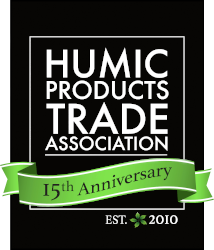Humic Products
Humic Products are composed either in-part or primarily of Humic Substances, Humic Acids and/or Fulvic Acids. The vast array of Humic Products includes naturally-occurring mined materials such as leonardite, oxidized lignite, carbonaceous shales, humates, or liquid products such as liquid humic acids and liquid fulvic acids, soluble or suspendable powders and gels. Humic Products may also be used in formulations such as livestock feeds, pet foods, cosmetics, nutraceuticals and other consumer products.
Humic Substances occur naturally in our environment and are the remains of a process called humification, which is the biodegradation of biomatter that then recombines and synthesizes into dark colored complex compounds with no definite chemical structure. Two distinct characteristics of humic substances are their highly-heterogeneous molecular structure and their resistance to further biodegradation. These qualities are important in the context of ecosystems because humic substances play critical roles in ecosystem function and health. Healthy ecosystems are resistant to degradation and contamination as well as being fit to carry out ecosystem functions, including sufficient cation exchange capacity, water-holding capacity and providing an environment for a diverse and healthy population of soil micro-organisms.
Humic Substances are very important in garden and crop production and the necessity of maintaining adequate concentrations in productive soils has been recognized and emphasized by agriculturists and scientists since the beginning of the 20th century. Agricultural researchers have investigated humic substances and gathered extensive scientific data on them since the late 1960’s.
Humic Acids and Fulvic Acids are extracted from Humic Substances. These organic compounds are differentiated according to their solubility in either acidic or basic solutions. They also vary in molecular size, carbon-hydrogen-oxygen-nitrogen content and their function in biological systems.
Definitions
Humic Substances are the dark colored substances that remain after the natural biodegradation of biomatter, and whose distinct characteristics are their relative resistance to further biodegradation and highly heterogeneous molecular structure.
Humic Acids is a broad term used in commerce and science to identify a class of isolated compounds that can be extracted from natural humic substances in a number of ways, typically with alkali solutions, and then precipitated from the alkaline aqueous solutions by acidification.
Fulvic Acids is a broad term used in commerce and science to identify a class of isolated compounds extracted from natural humic substances that are soluble in both alkali and acidic aqueous solutions.
Humic Products are composed either in part or primarily of humic substances, humic acids and/or fulvic acids.
Operationally Defined is a description of a material in terms specific to the process or validation tests used to determine the presence and/or quantity of that material. The term is typically used to describe the humic acids or fulvic acids that are extracted from humic substances.
Biogeochemical Characteristics of Humic Substances
Humic Substances are the natural dark-colored humified remains of decayed biomatter, ubiquitous in the environment as major components of natural organic matter in soils, water, and sediments, with the highest concentrations found in lake sediments, peat, and geological deposits of low rank brown coals, bituminous coals and shales.
Humic Substances are the extraordinarily complex organic remains of humification, which are amorphous mixtures of highly heterogeneous, chemically reactive yet refractory molecules that are resistant to further microbial breakdown, produced during early diagenesis in the decay of biomatter, and formed ubiquitously in the environment via processes involving reactions of chemical species randomly chosen from a pool of diverse molecules through random chemical alteration of precursor molecules.
The molecular structure of humic substances is unknown because they are devoid of a regularly recurring, extended skeletal entity. They are a unique class of environmental biochemicals because their essence resides in the combination of their extreme molecular heterogeneity, complexity and pronounced chemical reactivity. Humic substances from different sources display a remarkable uniformity in their gross properties.
Applications
The primary applications of Humic Products include commercial agriculture, as soil amendments and fertilizer additives, landscape and turf construction and maintenance, soil and water remediation, dietary supplements, livestock feeds and drilling mud additives.
HPTA Test Method Approved Products
Product Registration HPTA® Test Method Mark Approved Usage 2021 0527

